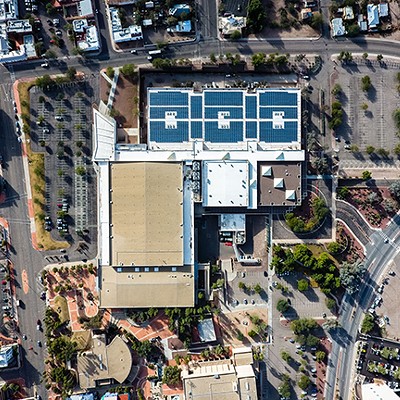The answer: Become the outer fringe.
The city is in the final stages of annexing a 28-mile swath of vacant land south of town. Several city officials, including Mayor Bob Walkup, have told the press the acquisition of this so-called Sahuarita Corridor will be an effective tool in planning for future growth--the land can be developed or not, as politicians and bureaucrats see fit. This way, Tucson can avoid falling prey to wildcat subdivisions on its fringes.
City officials see the annexation as having multiple uses--it represents a future haven for industry and research, a NAFTA distribution center, a place to build future Civano-type communities and even a safe place for desert plants and animals.
Ward 1 City Council member Jose Ibarra, however, suspects the motives for grabbing the Sahuarita Corridor are less grand and noble. Ibarra believes the city wants to annex the area primarily to obtain a large region for new water wells, as wells in the central field are closed because of new arsenic and radon standards being proposed by the Environmental Protection Agency.
Steve Pageau, Tucson Water's chief engineer, said the city already has a dozen or so wells operating in the Santa Cruz well field, which sits in the proposed annexation area, and additional wells are planned there.
Pageau told the Weekly that the proposed annexation would protect the well field. Currently, he said, about 9 million gallons of water from the Santa Cruz well field are blended with water from the Southern Avra Valley field and put into general distribution.
Ibarra said that in addition to the city's water concerns, local leaders believe that snapping up the Sahuarita Corridor will put them in a better position to annex the Palo Verde Corridor, as well. With the city limits already pressing the Palo Verde Corridor on the west, north and east, the proposed Sahuarita Corridor annexation would almost completely surround the Palo Verde area.
Alice Western, annexation coordinator for the City of Tucson, denied the city was currently interested in pursuing the annexation of the Palo Verde Corridor, even though several years ago the city tried but failed to annex that business and industrial area. "We looked into the Palo Verde, and see it as a break-even deal," she said. "Besides, no one from the Palo Verde is calling us, asking us to annex them."
Western told the Weekly that city planners don't anticipate development in the Sahuarita Corridor for 20 to 30 years.
The proposed annexation stretches from Old Nogales Highway east to I-10 and Houghton Road. When the annexation of 26 square miles of state land and two miles of private property is completed, the new southern boundary of the city will be within two miles of Sahuarita Road.
But while the new strategy may allow for better-planned development beyond the city's limits, the new annexation will puff the city's geographic girth to 223.916 square miles, including 108 square miles of vacant land, according to figures supplied by the city's planning director, Dave Taylor.
When the annexation is completed, the city's land mass will be almost half as large as the city of Los Angeles.
Geographically, Tucson has become a big-city without a big city population. L.A. has over 3.5 million city residents, while Tucson has only an estimated 467,000 citizens living within the city limits.
The elbow room may feel good, but someone has to pay the piper for the cost of infrastructure. And Ibarra maintains that carrying the tax burden of the city's future development is too much to ask of his constituents.
The Weekly inspected the Sahuarita Corridor along the southern stretch of Wilmot Road. Just past the Public Safety Academy the pavement ended and billows of dust from the few nearby cars completely obliterated the visibility on both sides of the slippery washboard road. Without paving Wilmot, the city could be inviting greater liability.
Residents living south of the proposed annexation told the Weekly that car accidents on Wilmot happen all the time. When an accident occurs, the county comes along the next day and grades the road.
Paving Wilmot through the heart of the annexed property won't be cheap. Nor will police, fire and paramedic protection. Ibarra doesn't think it is reasonable to ask city taxpayers to cover these and other infrastructure costs over the next 30 years.
Ward 5 council member Steve Leal, who supports the annexation, says Ibarra's concerns for his constituents shouldn't be trivialized. Nevertheless, "I believe Ibarra's constituents and mine could be better served in the long run by this annexation. Five years ago, I would have agreed with Jose. However, in the last eight years the city has made significant changes which now help pay the cost of new construction," said Leal.
Leal pointed out that the city's elimination of the sales tax waiver on new construction brings in millions of dollars. "If the land in the proposed annexation were to remain in the county where the county doesn't have a sales tax, Jose's and my constituents would pay for the new development through increased county property taxes," said Leal. Sixty percent of the county's taxpayers live in the city.
Using the Houghton Corridor annexation as an example, Leal explained how the city stands to reap $24 million in sales tax from the construction of 28,000 homes on approximately 7,700 acres. "That (sales tax) wasn't in place a year ago," said Leal, "and additionally we have eliminated the subsidy on new water meter hookups and all subsidies that used to be available to builders through our Department of Developmental Services. With the city's new policies to further make development pay for itself, the (Sahuarita Corridor) annexation makes sense for the city and for the taxpayers, plus we get the added benefit of planning the development."
Leal laughed and said, "So, I guess it's OK for the city to become 'the outer fringe' as long as the city has in place a system for an honest methodology that calculates real costs both on our fee structures and on our cost-of-services analysis for annexations.
"Now as for schools, that's another issue; we don't do schools."












